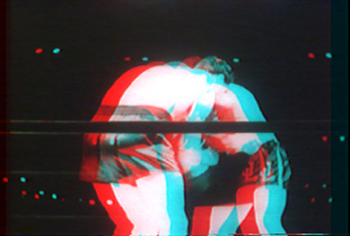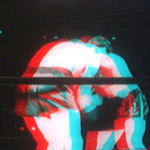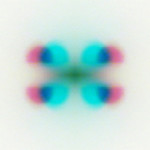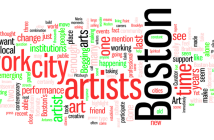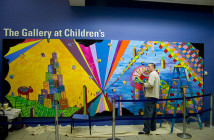Cinema is principally a visual medium; movement and light (i.e. color and shade) are its essential properties. Some of its ancillary aspects are visual composition, in the same way as painting, and synchronized sound, which only came about 30 years after cinema’s birth. Suara Welitoff’s new work in A Million Sunsets, currently at the Allston Skirt Gallery, is silent cinema, reduced to its essential properties.
There’s not much information available and there doesn’t need to be, as this Maud Morgan Prize winner of Boston relies only on visceral qualities. The images are very abstract and her clips are short; in most cases entire works are less than three minutes. Her reduction of video leaves her only one elemental step away from abstract painting or photography—the movement within the rectangle of the cinematic plane. It is difficult to resist discussing her new work within the context of painting, however. Her kaleidoscopic work, Rorschak 2 (2005) is made up of blurred magenta and turquoise forms in symmetrical, flowerlike patterns rotating over one another. The forms, on a white field, shift in size and shape and when layered together, produce their combined color of dark purple. The digital stills taken from Rorschak 2 are also titled Rorschak and follow the consecutive numbering; despite being still images, are thought of in the same series as the video. The white field could be thought of as a canvas or photographic paper.
Her work A Million Sunsets (2005) is also comprised of turquoise and red forms, though in this piece they are boxers. The video image is a negative of stock footage of Joe Louis pummeling an unknown opponent. Welitoff also separated the image’s color spectrum and reduced it to solid red and turquoise, creating two images, one red, one tourquoise, for each boxer. Her choice of titles is curious: At sundown, we can no longer see the full spectrum of light as the blue light is separated from the redder shades which constitute a sunset. This may be where her title is derived from, but the color and movement of the boxers (punching, ducking, feigning) is the subject of her work. The choice to use boxers seems relatively arbitrary considering the finished works: the boxers, their image manipulated yet their movement and shape remaining, are the medium—or meta-medium—of the work. The fluctuating focus of A Million Sunsets, blurring the boxers, causes the piece to be even more about color and movement. The boxers movement is random and her editing, though not fast, isn’t slow enough for the viewer to realize the narrative which occurs over the course of a boxing round. The ostensible subjects of the video- the boxers- become more and more indistinct, the qualities of only color and movement remain.
Even in Tell Me (2005) she resists narrative and subjectivity by keeping the segments of the piece short, giving us only slices of a meeting between a couple. She may have just chosen the segments where the tension between the two people is most intense. On this occasion there is music in the work, perhaps an effect of her work with the singer and songwriter Thalia Zedek. Along with Welitoff’s visuals, the music, from the Anthony Quinn tour de force Zorba the Greek, is hauntingly romantic. The video has no shading: it is solidly black where there is shadow and yellow where there is not. The music too lacks resonance and sounds as if it’s from a film from the first half of the 20th century, distancing the music’s sentimentality, but fine-tuning the intuitive response the viewer will have.
Her choice of ‘meta-mediums’: boxers, a couple, a crowded russian city square (in the blue tinted Russia (2004), do little for the viewer. There does not appear to be a logically coherent relationship between the boxers and the viewer; the relationship is barely visceral. The video clips she uses in her work are not prosaic, but they lack the significance for us to associate them with an actual time and place. In fact, in her image manipulation, she brings both original and stock footage to the same level of familiarity. We loose something from the stock footage, but at the same time, the original footage gains a universal quality. Welitoff seems to be seeking an intuitive response from the viewer somewhere more coherent than the emotional effects of an abstract painting but less coherent than a video montage. It is difficult to pinpoint as her works seems to vascillate between painting and video. Indeed, juxtaposed next to the Rorschak stills, the figures in the video stills from A Million Sunsets lose more of their ability to denote boxers and so move away from video. They remind us that videos are abstractions; mere color and light—paintings, as it would seem, with movement.
----
Links:
Allston Skirt Gallery
Suara’s Welitoff’s "Be the Boy"
"Suara Welitoff: A Million Sunsets" is on view from January 6th- 28th, 2006 at the Allston Skirt Gallery.
All images are courtesy of Suara Welitoff and Allston Skirt Gallery.

